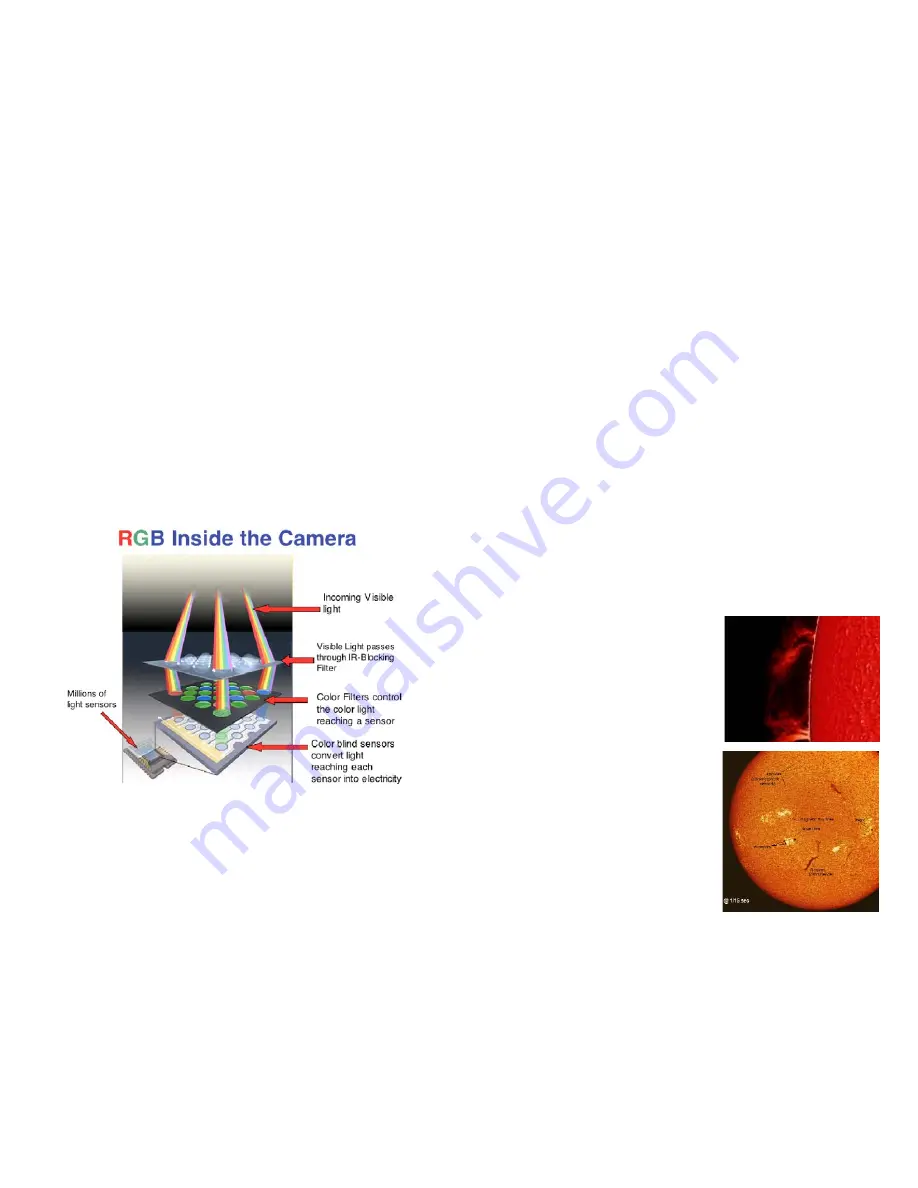
D
Daayyssttaarr rreecco
om
mm
meen
nd
dss M
MO
ON
NO
OC
CH
HR
RO
OM
MEE C
CC
CD
D iim
maaggiin
ngg
w
wh
heen
neevveerr p
po
ossssiib
bllee ffo
orr b
beesstt rreessu
ullttss..
The recent availability of CCD cameras and DSLR cameras has offered a simple opportu-
nity for solar observers to image the Sun in Hydrogen Alpha with a Digital SLR camera.
Please be advised, however, that due to the nature of monochromatic light and its
effects on a CCD camera, certain effects usually occur.
The DSLR imager must be aware that most camera manufacturers (Canon and Nikon)
use an IR blocking filter which greatly reduces the transmission of Hydrogen Alpha light.
DSLR cameras without this IR blocking filter will have better sensitivity imaging in
Hydrogen Alpha.
The imager should also appreciate that the COLOR CCD chip is constructed in a way that
only 1:4 sensors detect red light. The other 3 sensors only detect blue and green. So a
color CCD chip (in a DSLR or a CCD camera) will only offer 1/4 the sensitivity and 1/2 the
resolution of a monochrome chip.
Another effect present in CCD imaging of monochrome light is the interference pattern
- or Newton's Rings. The effect is similar to interference testing of an optical surface
between two flat surfaces. The sensor and cover slip cause a small interferometer
inside the camera and cause a Newton's Ring moire' pattern. The CCD chip must be tilt-
ed to a minor degree to prevent this pattern. Recent advances in aftermarket adapters
offer a simplified solution for the issue. This effect is a concern for both color and
monochrome sensors. An optional accessory is available from DayStar (MG-0408)
which can be used between the DSLR and SolaREDi to adjust the light angle and extinct
the interference pattern.
8
5
Bandpass Expectations:
0.7Å users will find that prominences are easily
visible and very well-pronounced with a 0.7Å filter.
Surface structure is not very contrasted, but it is
possible to see mottling on the surface and large
flares, plages and active regions.
0.5Å users will see prominences but not quite as
broad as with a 0.7Å due to wing shift in the
prominence. Surface detail will be much stronger
with a 0.5Å, revealing more detail in active
regions, filaments, spicule, and all other features.
0.3Å users will see only very thin, hairline promi-
nences, but surface contrast will be very defined
and sharp. Soft chromosphere will appear in high-
est detail with .3Å.
A word about daytime seeing and limiting resolution:
During the daytime, radiant heating from the sun affects seeing significantly.
Characterized by turbulence or shimmering as seen over a hot street, seeing can
cause significant impact on quality of solar observations.
Bad seeing is caused by air of different temperatures mixing. This typically happens
within the lowest 10 feet of air. It occurs most often over pavement, dark objects,
rooftops and sometimes trees.
High cirrus clouds or “scuz” will cause scattering of sunlight in the high atmosphere
which often makes for bad viewing conditions. A classic sign of high cirrus clouds is
the inability to achieve focus, or the need to “chase focus”. A jet-stream moving
overhead can also hurt seeing conditions even on a clear day.
While many of these conditions are beyond our control, observing in an area with
ideal conditions without pavement in the direction of viewing and on days with no
high cirrus will offer best results. Grass is the best environment for daytime seeing
stability.
The SolaREDi 60mm has a limiting resolution at 6562.8 of approximately 2.8 arc sec-
onds. Over-magnification of the image will have resolution limitations in which fea-
tures can not be resolved. Also note that the sun’s limb in hydrogen alpha is soft, with
a fuzzy layer of chromosphere surrounding the surface. Using eyepieces higher than
25mm in power, it is challenging to achieve focus on the limb. For users who are
interested in higher magnification, we suggest one of our other models of ION or
Quantum DayStar filters which can mount to your existing telescope and be used up
to 6.5” in clear aperture.






